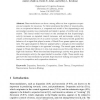62 search results - page 7 / 13 » Evolving explicit opponent models in game playing |
CEC
2009
IEEE
14 years 2 months ago
2009
IEEE
— Using a game-theoretic model combined with the evolutionary model, we investigate the conditions under which the desirable interaction rules will evolve and sustain in various ...
CVPR
2010
IEEE
14 years 9 days ago
2010
IEEE
Videos of multi-player team sports provide a challenging domain for dynamic scene analysis. Player actions and interactions are complex as they are driven by many factors, such as...
SAB
2010
Springer
13 years 5 months ago
2010
Springer
Abstract. Neuromodulators can have a strong effect on how organisms cooperate and compete for resources. To better understand the effect of neuromodulation on cooperative behavior,...
TCIAIG
2010
13 years 2 months ago
2010
Abstract--Fingerprinting operators generate functional signatures of game players and are useful for their automated analysis independent of representation or encoding. The theory ...
ATAL
2007
Springer
14 years 1 months ago
2007
Springer
Multiagent environments are often not cooperative nor collaborative; in many cases, agents have conflicting interests, leading to adversarial interactions. This paper presents a ...


